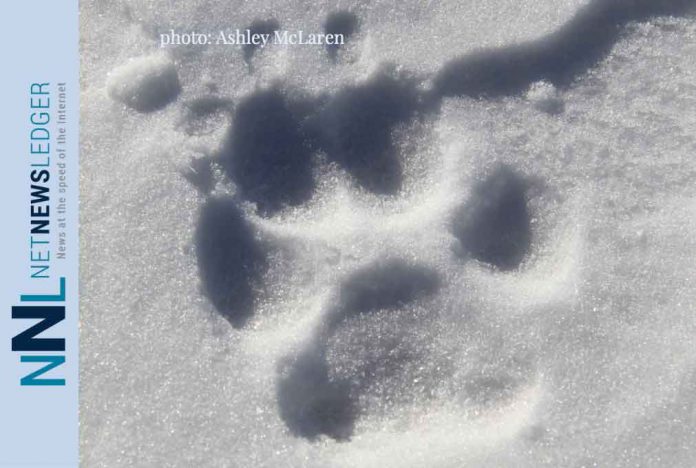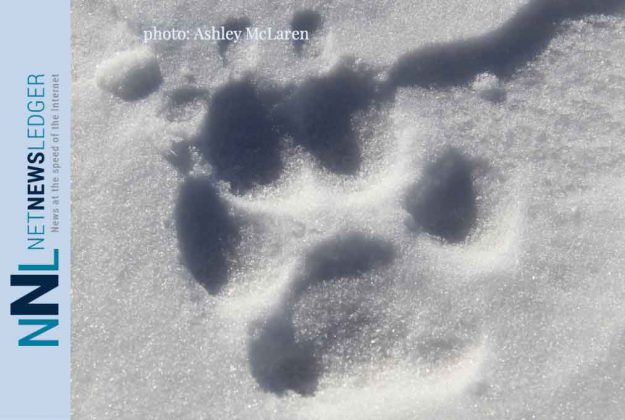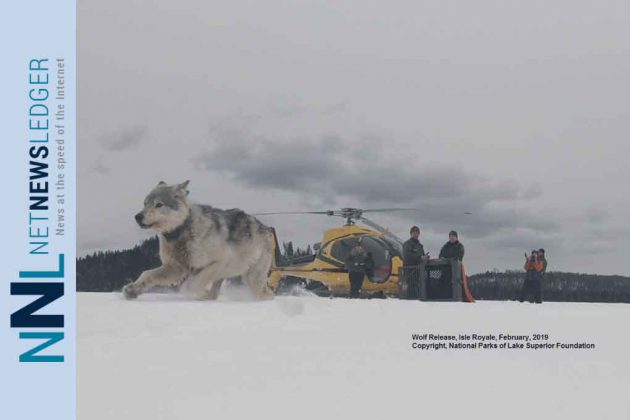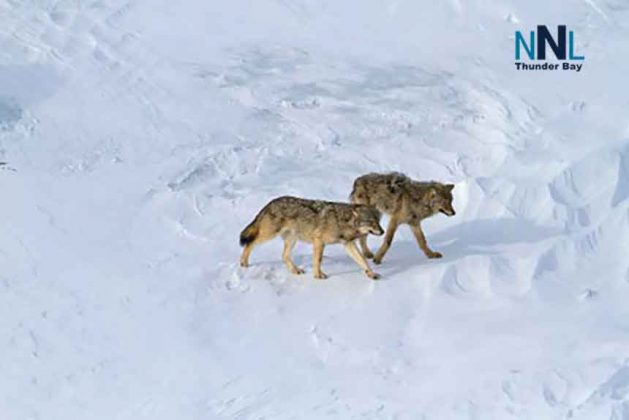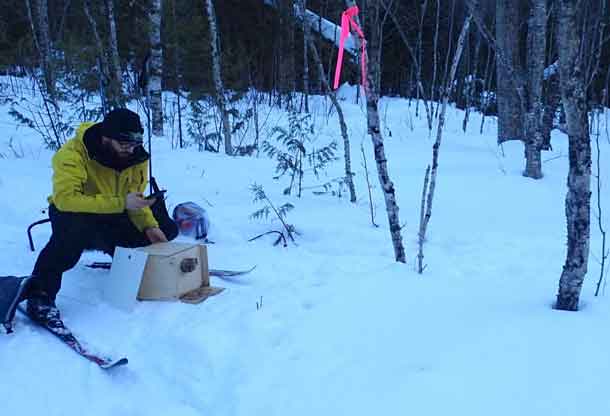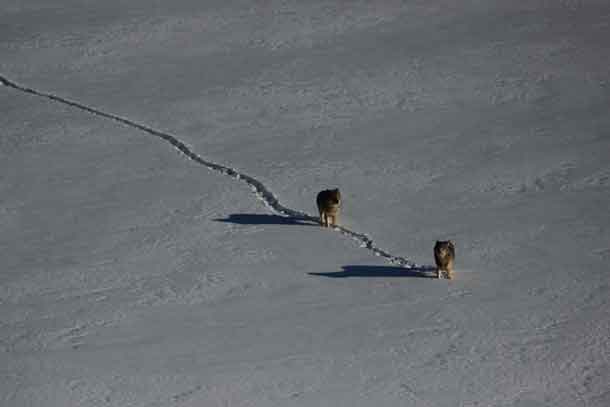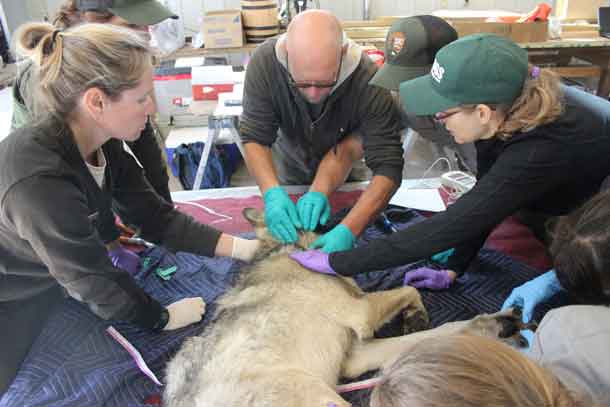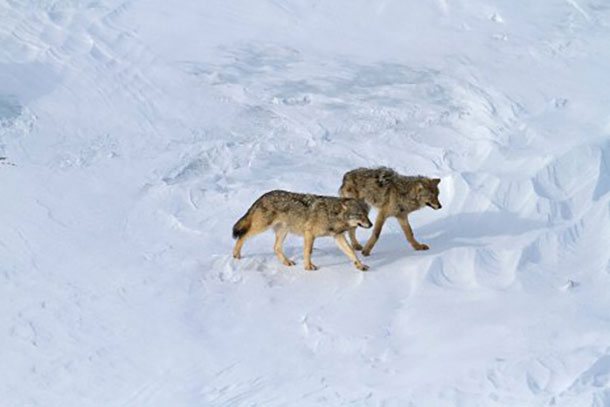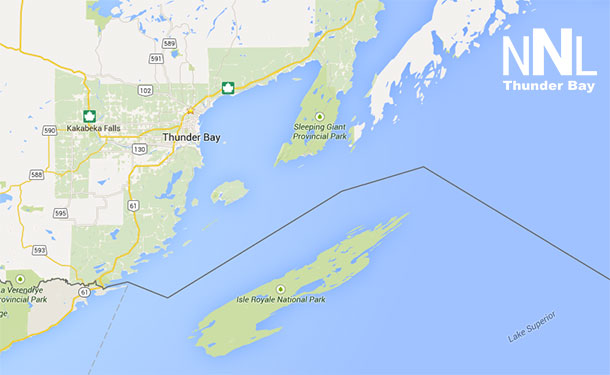ISLE ROYALE – Over the past months, efforts to re-introduce wolves to Isle Royale in Michigan have continued. Fifteen wolves. 2,060 moose. Extensive ice and deep, powdery snow. Michigan Tech researchers have released the annual Winter Study report. In its 61st year, the study is the longest-running examination of a predator-prey relationship in the world.
The report chronicles the four-week research expedition to the island, where researchers track — by ski and plane — wolves and moose, collar moose, and catalogue the cascading effects of an ecosystem that has lacked a healthy population of apex predators for a number of years.
New Tracks in the Snow
Prior to this fall and winter’s wolf reintroductions, the wolf population on the remote island had remained at just two — a strongly bonded, but also highly inbred male-female pair — for three years. The moose population, lacking predation, expanded by an average of 19% each year during the past eight years since 2011 when the wolf population first dwindled to fewer than 10 individuals. Consequently, primary plant species in moose diets — balsam fir and watershield — dropped precipitously.
The National Park Service (NPS), after an extensive review process, decided to introduce new wolves to the island. In September and October 2018, NPS introduced four Minnesota-born wolves (one male and three females) to the island. In late October, the male wolf died and on January 31, 2019, one of the female wolves left the island by crossing the ice bridge that had formed on Lake Superior, which reached nearly 95% ice cover.
In late February, NPS in collaboration with the Ontario Ministry of Natural Resources (OMNRF), introduced four Canadian-born wolves, including a male and female from a pack near Wawa, Ontario, and two males from Michipicoten Island, Ontario. In late March, NPS and OMNRF introduced seven more wolves to the island, including three males and three females from Michipicoten and one male from near Wawa.
For researchers, perhaps equal parts vexing and exciting are the unanswered questions about the future of the wolves on the island.
“Some of the most important questions at this point are: Will there be pups this year? How quickly will the wolves form a pack, and how many packs?” said John Vucetich, professor of ecology at Michigan Tech and report co-author. “As is so often the case with nature, the answer is, nobody knows — but three packs is the likely answer.”
The Michigan Tech School of Forest Resources and Environmental Science researchers speculated that wolf pups could be possible this year, but the new wolves were introduced to the island near the end of the traditional breeding season, so only time will tell.
Vucetich added that there are similar questions pertaining to the moose. “What’s going to happen to the moose population? Will it keep increasing from 2,060, or level off, or decline quickly or slowly? The answer is the same, nobody knows.”
To seek the answers, researchers fitted the first GPS-enabled radio collars since 1985 to the newly introduced wolves and 20 moose. The collaring efforts are part of a collaboration with University of Minnesota College of Veterinary Medicine, National Park Service and Grand Portage Band of Lake Superior Chippewa.
New Collars, More Data
Collaring the moose will also help researchers understand the effects of predation, as well as other factors that influence the moose population, including forage abundance, parasites and climate.
“As soon as you start collaring individuals you learn about them in great detail; they all have interesting stories,” said Rolf Peterson.
The researchers are also excited about their collaboration with Jennifer Forbey, an associate professor of biology at Boise State University, who studies the chemical ecology of herbivory.
Scientists are coming to understand that the reason many herbivores eat what they eat is due to subtle chemical differences in the plants. Isle Royale offers a unique environment in which to study herbivory.
“Most people study a herbivore’s decision of what to eat when there are no predators involved,” Vucetich said. “They’ve got all day to figure out which plant they want. But when exposed to a predator, they still have a choice of which plant to eat, but the calculus of the decision is more complex.”
And what individual moose elect to eat may have a profound impact on their population as a whole. Lacking predators, the growing moose population has ravaged much of the available forage on the island, and that has consequences.
“We expect there might be a slowing down of moose population growth next year, at least at the west end of the island,” said Sarah Hoy, assistant research professor. “The moose have severely damaged much of the vegetation they rely on during winter on the western end of the island. And it was such a deep-snow winter, it’ll have been more difficult for them to get around and find food.”
According to the report, moose browsing is one factor relating to a decline in the number of mature fir trees. In 1988, 473 mature balsam fir trees were tagged on the western end of the island. Only 28 (6%) of those tagged trees remained in 2018.
Watershield, a floating-leafed aquatic plant, has also experienced a decline as the moose population grew. In the late 2000s, watershield covered as much as 90% of the water surface in ponds on the eastern side of the island. By 2018, it was not readily found in aquatic areas.
Next Steps
Reintroducing a thriving wolf population to Isle Royale also has an effect on the island’s other residents, which include beavers and foxes. Wolves eat beavers as well as moose, and so the beaver population, which has been booming since 2012, may eventually decline to levels of a decade ago, about 20% of current numbers. Foxes, which are scavengers, will likely benefit from the return of the island’s apex predator.
Also of interest to the scientists is evidence of yet additional wolves who may have crossed the ice bridge and visited Isle Royale during the winter. Each winter, the Isle Royale wolf-moose project embeds a husband-wife team, Ky Koitzsch and Lisa Osborn, to observe the moose and wolves by skis, and they found evidence of the tracks of an unknown wolf on the island. The aerial survey suggested that perhaps three wolves crossed the ice and circumnavigated the island, but this may have been just a quick visit followed by a return home to the mainland.
Peterson, Hoy and Vucetich are headed back to the island in May to conduct summer research, along with six students who will showcase their progress on the project’s social media.
As usual, four to five dozen volunteers will head to the island for the annual Moosewatch Expedition to collect bones at locations where the collared wolves seem to have lingered long enough to presume they were feeding on a dead moose.
“When we’re there in the winter, we learn a tremendous amount about the moose population, but this summer we are hoping to learn a lot more detailed information about moose behavior and what they like to eat, depending on how tolerant the collared moose are of being watched,” Peterson said. “This summer should likewise prove valuable in determining the trajectory of both wolf and moose populations. This is definitely a notable year.”
Indeed, there is a sense of renewal in this year’s report. For the first time in 10 years, the researchers spotted fresh wolf tracks at Windigo.

